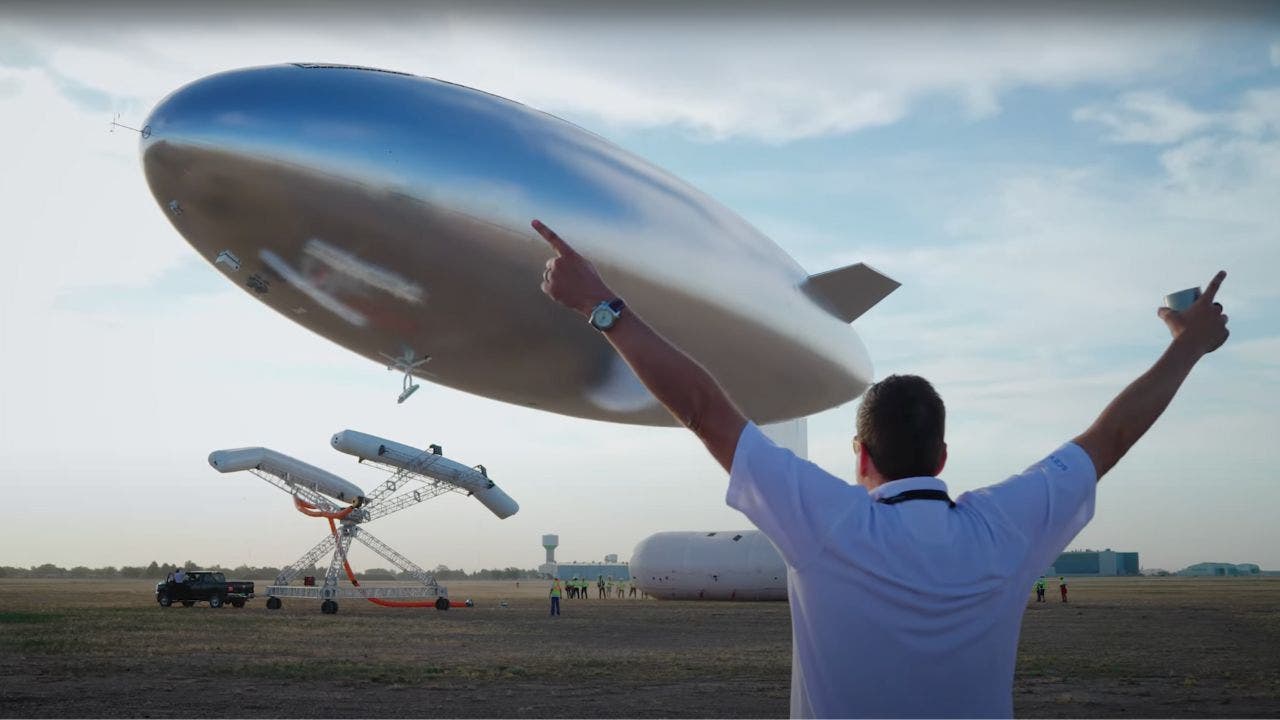Of all the jarring things I’ve witnessed on the National Mall, nothing will beat the image of the first thing I saw after I cleared security at the Army festival: a child, sitting at the controls of an M119A3 Howitzer, being instructed by a soldier on how to aim it, as his red-hatted parents took a photo with the Washington Monument in the background.
Technology
Solar-powered blimp could bring high-speed internet to your area

Have you ever felt the frustration of losing internet access while camping, hiking or living in a remote area? Whether you’re trying to connect with family, access important information or simply enjoy your favorite streaming service, losing internet access can be a real bummer. For many, this is a daily struggle. However, new technology from a company called Sceye could be the answer to these connectivity woes, offering a solution to the digital divide that leaves so many people in the dark.
GET SECURITY ALERTS, EXPERT TIPS – SIGN UP FOR KURT’S NEWSLETTER – THE CYBERGUY REPORT HERE
Sceye HAPS (Sceye) (Kurt “CyberGuy” Knutsson)
Enter the Sceye HAPS: A blimp-like aircraft with a mission
The Sceye HAPS is not your average aircraft. This 213-foot-long uncrewed helium-filled behemoth is designed to soar to stratospheric heights, hovering between 60,000 and 65,000 feet above the Earth’s surface. What makes it truly special is its ability to beam high-speed internet to areas that traditional infrastructure cannot reach.

Sceye HAPS (Sceye) (Kurt “CyberGuy” Knutsson)
IS THIS 656-FOOT AIRYACHT THE LUXURY TRANSPORTATION OF THE FUTURE?
Solar-powered stratospheric sentinel
One of the most impressive features of the Sceye HAPS is its power source. The aircraft is covered in a “solar cape” made of gallium selenide and gallium arsenide solar cells, allowing it to harness the sun’s energy to stay aloft for months at a time. This sustainable power approach enables the HAPS to perform its critical tasks continuously, from providing internet access to monitoring environmental conditions.
HOW TO REMOVE YOUR PRIVATE DATA FROM THE INTERNET

Sceye HAPS (Sceye) (Kurt “CyberGuy” Knutsson)
THIS FLYING ELECTRIC VEHICLE BREAKS RECORD WITH 523-MILE NONSTOP FLIGHT
Breaking records and bridging divides
The Sceye HAPS is already making waves in the real world. It set a long-range record by maintaining a data connection across a distance of over 87 miles, far exceeding the typical LTE range. This achievement has significant implications for bridging the digital divide, especially in areas like the Navajo Nation, where the HAPS is part of a project to provide universal broadband access. By demonstrating its ability to connect over such vast distances, the Sceye HAPS is proving its potential to revolutionize internet access in remote and underserved communities.

Sceye HAPS (Sceye) (Kurt “CyberGuy” Knutsson)
NASA’S DRAGONFLY DRONE CLEARED FOR FLIGHT TO SATURN’S MOON, TITAN
More than just internet
While providing internet access is a key function of the Sceye HAPS, its capabilities extend far beyond that. The aircraft is also being used for climate and environmental monitoring, disaster response, forest fire detection, and tracking and measuring methane emissions as part of an EPA study.

Sceye HAPS (Sceye) (Kurt “CyberGuy” Knutsson)
Recent milestones and future plans
The Sceye HAPS continues to impress with its technological advancements. In a recent flight, it demonstrated its ability to charge its batteries during the day and use that power to stay airborne overnight, a crucial step towards long-duration missions. With 20 test flights under its belt and commercial deployment planned for 2025, the future looks bright for this stratospheric innovation.
SUBSCRIBE TO KURT’S YOUTUBE CHANNEL FOR QUICK VIDEO TIPS ON HOW TO WORK ALL OF YOUR TECH DEVICES

Sceye HAPS (Sceye) (Kurt “CyberGuy” Knutsson)
Kurt’s key takeaways
The Sceye HAPS is shaking things up in the world of global connectivity. Think of it as a high-tech blimp that’s on a mission to bring the internet to places that have been left in the digital dark ages. By floating way up in the stratosphere, this clever contraption is tackling problems that have stumped tech experts for years. This flying innovation could be a game-changer in making our world more connected and better prepared for whatever Mother Nature throws our way. Sure, there are still some kinks to work out. But the way things are going, it looks like the Sceye HAPS is proving that when it comes to solving big global problems, sometimes the best solution is to aim high, really high.
Do you have any concerns about high-altitude aircraft like the Sceye HAPS floating in the stratosphere? Let us know by writing us at Cyberguy.com/Contact.
For more of my tech tips and security alerts, subscribe to my free CyberGuy Report Newsletter by heading to Cyberguy.com/Newsletter.
Ask Kurt a question or let us know what stories you’d like us to cover.
Follow Kurt on his social channels:
Answers to the most asked CyberGuy questions:
New from Kurt:
Copyright 2024 CyberGuy.com. All rights reserved.

Technology
Tanks, guns and face-painting

The primary stated reason for the Grand Military Parade is to celebrate the US Army’s 250th birthday. The second stated reason is to use the event for recruiting purposes. Like other military branches, the Army has struggled to meet its enlistment quotas for over the past decade. And according to very defensive Army spokespeople trying to convince skeptics that the parade was not for Donald Trump’s birthday, there had always been a festival planned on the National Mall that day, and it had been in the works for over two years, and the parade, tacked on just two months ago, was purely incidental. Assuming that their statement was true, I wasn’t quite sure if they had anticipated so many people in blatant MAGA swag in attendance — or how eager they were to bring their children and hand them assault rifles.
There had been kid-friendly events planned: an NFL Kids Zone with a photo op with the Washington Commanders’ mascot, a few face-painting booths, several rock-climbing walls. But they were dwarfed, literally, by dozens of war machines parked along the jogging paths: massive tanks, trucks with gun-mounted turrets, assault helicopters, many of them currently used in combat, all with helpful signs explaining the history of each vehicle, as well as the guns and ammo it could carry. And the families — wearing everything from J6 shirts to Vineyard Vines — were drawn more to the military vehicles, all-too-ready to place their kids in the cockpit of an AH-1F Cobra 998 helicopter as they pretended to aim the nose-mounted 3-barrelled Gatling Cannon. Parents told their children to smile as they poked their little heads out of the hatch of an M1135 Stryker armored vehicle; reminded them to be patient as they waited in line to sit inside an M109A7 self-propelled Howitzer with a 155MM rifled cannon.

But seeing a kid’s happiness of being inside a big thing that goes boom was nothing compared to the grownups’ faces when they got the chance to hold genuine military assault rifles — especially the grownups who had made sure to wear Trump merch during the Army’s birthday party. (Some even handed the rifles to their children for their own photo ops.) It seemed that not even a free Army-branded Bluetooth speaker could compare to how fucking sick the modded AR-15 was. Attendees were in raptures over the Boston Dynamics robot dog gun, the quadcopter drone gun, or really any of the other guns available (except for those historic guns, those were only maybe cool).
However many protesters made it out to DC, they were dwarfed by thousands of people winding down Constitution Avenue to enter the parade viewing grounds: lots of MAGA heads, lots of foreign tourists, all people who really just like to see big, big tanks. “Angry LOSERS!” they jeered at the protesters. (“Don’t worry about them,” said one cop, “they lost anyways.”) and after walking past them, crossing the bridge, winding through hundreds of yards of metal fencing, Funneling through security, crossing a choked pedestrian bridge over Constitution Ave, I was finally dumped onto the parade viewing section: slightly muggy and surprisingly navigable. But whatever sluggishness the crowd was feeling, it would immediately dissipate the moment a tank turned the corner — and the music started blasting.
Americans have a critical weakness for 70s and 80s rock, and this crowd seemed more than willing to look past the questionable origins of the parade so long as the soundtrack had a sick guitar solo. An M1 Abrams tank driving past you while Barracuda blasts on a tower of speakers? Badass. Black Hawk helicopters circling the Washington Monument and disappearing behind the African-American history museum, thrashing your head to “separate ways” by Journey? Fucking badass. ANOTHER M1 ABRAMS TANK?!?!! AND TO FORTUNATE SON??!?!? “They got me fucking hooked,” a young redheaded man said behind me as the crowd screamed for the waving drivers. (The tank was so badass that the irony of “Fortunate Son” didn’t matter.)

When you listen to the hardest fucking rock soundtrack long enough, and learn more about how fucking sick the Bradley Fighting Vehicles streaming by you are (either from the parade announcer or the tank enthusiast next to you), an animalistic hype takes over you — enough to drown out all the nationwide anger about the parade, the enormity of Trump’s power grab, the fact that two Minnesota Democratic lawmakers were shot in their homes just that morning, the riot police roving the streets of LA.
It helped that it didn’t rain. It helped that the only people at the parade were the diehards who didn’t care if they were rained out. And by the end of the parade, they didn’t even bother to stay for Trump’s speech, beelining back to the bridge at the first drop of rain.
The only thing that mattered to this crowd inside the security perimeter — more than the Army’s honor and history, and barely more than Trump himself — was firepower, strength, hard rock, and America’s unparalleled, world-class ability to kill.
Technology
How addresses are collected and put on people finder sites

NEWYou can now listen to Fox News articles!
Your home address might be easier to find online than you think.
A quick search of your name could turn up past and current locations, all thanks to people finder sites.
These data broker sites quietly collect and publish personal details without your consent, making your privacy vulnerable with just a few clicks.
Sign up for my FREE CyberGuy Report
Get my best tech tips, urgent security alerts, and exclusive deals delivered straight to your inbox. Plus, you’ll get instant access to my Ultimate Scam Survival Guide — free when you join.
A woman searching for herself online. (Kurt “CyberGuy” Knutsson)
How your address gets exposed online and who’s using it
If you’ve ever searched for your name and found personal details, like your address, on unfamiliar websites, you’re not alone. People finder platforms collect this information from public records and third-party data brokers, then publish and share it widely. They often link your address to other details such as phone numbers, email addresses and even relatives.
11 EASY WAYS TO PROTECT YOUR ONLINE PRIVACY IN 2025
While this data may already be public in various places, these sites make it far easier to access and monetize it at scale. In one recent breach, more than 183 million login credentials were exposed through an unsecured database. Many of these records were linked to physical addresses, raising concerns about how multiple sources of personal data can be combined and exploited.
Although people finder sites claim to help reconnect friends or locate lost contacts, they also make sensitive personal information available to anyone willing to pay. This includes scammers, spammers and identity thieves who use it for fraud, harassment, and targeted scams.

A woman searching for herself online. (Kurt “CyberGuy” Knutsson)
How do people search sites get your home address?
First, let’s define two sources of information; public and private databases that people search sites use to get your detailed profile, including your home address. They run an automated search on these databases with key information about you and add your home address from the search results.
1. Public sources
Your home address can appear in:
- Property deeds: When you buy or sell a home, your name and address become part of the public record.
- Voter registration: You need to list your address when voting.
- Court documents: Addresses appear in legal filings or lawsuits.
- Marriage and divorce records: These often include current or past addresses.
- Business licenses and professional registrations: If you own a business or hold a license, your address can be listed.
WHAT IS ARTIFICIAL INTELLIGENCE (AI)?
These records are legal to access, and people finder sites collect and repackage them into detailed personal profiles.
2. Private sources
Other sites buy your data from companies you’ve interacted with:
- Online purchases: When you buy something online, your address is recorded and can be sold to marketing companies.
- Subscriptions and memberships: Magazines, clubs and loyalty programs often share your information.
- Social media platforms: Your location or address details can be gathered indirectly from posts, photos or shared information.
- Mobile apps and websites: Some apps track your location.
People finder sites buy this data from other data brokers and combine it with public records to build complete profiles that include address information.

A woman searching for herself online. (Kurt “CyberGuy” Knutsson)
What are the risks of having your address on people finder sites?
The Federal Trade Commission (FTC) advises people to request the removal of their private data, including home addresses, from people search sites due to the associated risks of stalking, scamming and other crimes.
People search sites are a goldmine for cybercriminals looking to target and profile potential victims as well as plan comprehensive cyberattacks. Losses due to targeted phishing attacks increased by 33% in 2024, according to the FBI. So, having your home address publicly accessible can lead to several risks:
- Stalking and harassment: Criminals can easily find your home address and threaten you.
- Identity theft: Scammers can use your address and other personal information to impersonate you or fraudulently open accounts.
- Unwanted contact: Marketers and scammers can use your address to send junk mail or phishing or brushing scams.
- Increased financial risks: Insurance companies or lenders can use publicly available address information to unfairly decide your rates or eligibility.
- Burglary and home invasion: Criminals can use your location to target your home when you’re away or vulnerable.
How to protect your home address
The good news is that you can take steps to reduce the risks and keep your address private. However, keep in mind that data brokers and people search sites can re-list your information after some time, so you might need to request data removal periodically.
I recommend a few ways to delete your private information, including your home address, from such websites.
1. Use personal data removal services: Data brokers can sell your home address and other personal data to multiple businesses and individuals, so the key is to act fast. If you’re looking for an easier way to protect your privacy, a data removal service can do the heavy lifting for you, automatically requesting data removal from brokers and tracking compliance.
While no service can guarantee the complete removal of your data from the internet, a data removal service is really a smart choice. They aren’t cheap — and neither is your privacy. These services do all the work for you by actively monitoring and systematically erasing your personal information from hundreds of websites. It’s what gives me peace of mind and has proven to be the most effective way to erase your personal data from the internet. By limiting the information available, you reduce the risk of scammers cross-referencing data from breaches with information they might find on the dark web, making it harder for them to target you. Check out my top picks for data removal services here.
Get a free scan to find out if your personal information is already out on the web
2. Opt out manually : Use a free scanner provided by a data removal service to check which people search sites that list your address. Then, visit each of these websites and look for an opt-out procedure or form: keywords like “opt out,” “delete my information,” etc., point the way.
Follow each site’s opt-out process carefully, and confirm they’ve removed all your personal info, otherwise, it may get relisted.
3. Monitor your digital footprint: I recommend regularly searching online for your name to see if your location is publicly available. If only your social media profile pops up, there’s no need to worry. However, people finder sites tend to relist your private information, including your home address, after some time.
4. Limit sharing your address online: Be careful about sharing your home address on social media, online forms and apps. Review privacy settings regularly, and only provide your address when absolutely necessary. Also, adjust your phone settings so that apps don’t track your location.
Kurt’s key takeaways
Your home address is more vulnerable than you think. People finder sites aggregate data from public records and private sources to display your address online, often without your knowledge or consent. This can lead to serious privacy and safety risks. Taking proactive steps to protect your home address is essential. Do it manually or use a data removal tool for an easier process. By understanding how your location is collected and taking measures to remove your address from online sites, you can reclaim control over your personal data.
How do you feel about companies making your home address so easy to find? Let us know by writing us at Cyberguy.com/Contact
For more of my tech tips and security alerts, subscribe to my free CyberGuy Report Newsletter by heading to Cyberguy.com/Newsletter
Ask Kurt a question or let us know what stories you’d like us to cover.
Follow Kurt on his social channels:
Answers to the most-asked CyberGuy questions:
New from Kurt:
Copyright 2025 CyberGuy.com. All rights reserved.
Technology
Inside Mark Zuckerberg’s AI hiring spree

AI researchers have recently been asking themselves a version of the question, “Is that really Zuck?”
As first reported by Bloomberg, the Meta CEO has been personally asking top AI talent to join his new “superintelligence” AI lab and reboot Llama. His recruiting process typically goes like this: a cold outreach via email or WhatsApp that cites the recruit’s work history and requests a 15-minute chat. Dozens of researchers have gotten these kinds of messages at Google alone.
For those who do agree to hear his pitch (amazingly, not all of them do), Zuckerberg highlights the latitude they’ll have to make risky bets, the scale of Meta’s products, and the money he’s prepared to invest in the infrastructure to support them. He makes clear that this new team will be empowered and sit with him at Meta’s headquarters, where I’m told the desks have already been rearranged for the incoming team.
Most of the headlines so far have focused on the eye-popping compensation packages Zuckerberg is offering, some of which are well into the eight-figure range. As I’ve covered before, hiring the best AI researcher is like hiring a star basketball player: there are very few of them, and you have to pay up. Case in point: Zuckerberg basically just paid 14 Instagrams to hire away Scale AI CEO Alexandr Wang.
It’s easily the most expensive hire of all time, dwarfing the billions that Google spent to rehire Noam Shazeer and his core team from Character.AI (a deal Zuckerberg passed on). “Opportunities of this magnitude often come at a cost,” Wang wrote in his note to employees this week. “In this instance, that cost is my departure.”
Zuckerberg’s recruiting spree is already starting to rattle his competitors. The day before his offer deadline for some senior OpenAI employees, Sam Altman dropped an essay proclaiming that “before anything else, we are a superintelligence research company.” And after Zuckerberg tried to hire DeepMind CTO Koray Kavukcuoglu, he was given a larger SVP title and now reports directly to Google CEO Sundar Pichai.
I expect Wang to have the title of “chief AI officer” at Meta when the new lab is announced. Jack Rae, a principal researcher from DeepMind who has signed on, will lead pre-training. Meta certainly needs a reset. According to my sources, Llama has fallen so far behind that Meta’s product teams have recently discussed using AI models from other companies (although that is highly unlikely to happen). Meta’s internal coding tool for engineers, however, is already using Claude.
While Meta’s existing AI researchers have good reason to be looking over their shoulders, Zuckerberg’s $14.3 billion investment in Scale is making many longtime employees, or Scaliens, quite wealthy. They were popping champagne in the office this morning.
Then, Wang held his last all-hands meeting to say goodbye and cried. He didn’t mention what he would be doing at Meta. I expect his new team will be unveiled within the next few weeks after Zuckerberg gets a critical number of members to officially sign on.
Apple is accustomed to being on top of the tech industry, and for good reason: the company has enjoyed a nearly unrivaled run of dominance.
After spending time at Apple HQ this week for WWDC, I’m not sure that its leaders appreciate the meteorite that is heading their way. The hubris they display suggests they don’t understand how AI is fundamentally changing how people use and build software.
Heading into the keynote on Monday, everyone knew not to expect the revamped Siri that had been promised the previous year. Apple, to its credit, acknowledged that it dropped the ball there, and it sounds like a large language model rebuild of Siri is very much underway and coming in 2026.
The AI industry moves much faster than Apple’s release schedule, though. By the time Siri is perhaps good enough to keep pace, it will have to contend with the lock-in that OpenAI and others are building through their memory features. Apple and OpenAI are currently partners, but both companies want to ultimately control the interface for interacting with AI, which puts them on a collision course.
Apple’s decision to let developers use its own, on-device foundational models for free in their apps sounds strategically smart, but unfortunately, the models look far from leading. Apple ran its own benchmarks, which aren’t impressive, and has confirmed a measly context window of 4,096 tokens. It’s also saying that the models will be updated alongside its operating systems — a snail’s pace compared to how quickly AI companies move.
I’d be surprised if any serious developers use these Apple models, although I can see them being helpful to indie devs who are just getting started and don’t want to spend on the leading cloud models. I don’t think most people care about the privacy angle that Apple is claiming as a differentiator; they are already sharing their darkest secrets with ChatGPT and other assistants.
Some of the new Apple Intelligence features I demoed this week were impressive, such as live language translation for calls. Mostly, I came away with the impression that the company is heavily leaning on its ChatGPT partnership as a stopgap until Apple Intelligence and Siri are both where they need to be.
AI probably isn’t a near-term risk to Apple’s business. No one has shipped anything close to the contextually aware Siri that was demoed at last year’s WWDC. People will continue to buy Apple hardware for a long time, even after Sam Altman and Jony Ive announce their first AI device for ChatGPT next year. AR glasses aren’t going mainstream anytime soon either, although we can expect to see more eyewear from Meta, Google, and Snap over the coming year.
In aggregate, these AI-powered devices could begin to siphon away engagement from the iPhone, but I don’t see people fully replacing their smartphones for a long time. The bigger question after this week is whether Apple has what it takes to rise to the occasion and culturally reset itself for the AI era.
I would have loved to hear Tim Cook address this issue directly, but the only interview he did for WWDC was a cover story in Variety about the company’s new F1 movie.
- AI agents are coming. I recently caught up with Databricks CEO Ali Ghodsi ahead of his company’s annual developer conference this week in San Francisco. Given Databricks’ position, he has a unique, bird’s-eye view of where things are headed for AI. He doesn’t envision a near-term future where AI agents completely automate real-world tasks, but he does predict a wave of startups over the next year that will come close to completing actions in areas such as travel booking. He thinks humans will need (and want) to approve what an agent does before it goes off and completes a task. “We have most of the airplanes flying automated, and we still want pilots in there.”
- Buyouts are the new normal at Google. That much is clear after this week’s rollout of the “voluntary exit program” in core engineering, the Search organization, and some other divisions. In his internal memo, Search SVP Nick Fox was clear that management thinks buyouts have been successful in other parts of the company that have tried them. In a separate memo I saw, engineering exec Jen Fitzpatrick called the buyouts an “opportunity to create internal mobility and fresh growth opportunities.” Google appears to be attempting a cultural reset, which will be a challenging task for a company of its size. We’ll see if it can pull it off.
- Evan Spiegel wants help with AR glasses. I doubt that his announcement that consumer glasses are coming next year was solely aimed at AR developers. Telegraphing the plan and announcing that Snap has spent $3 billion on hardware to date feels more aimed at potential partners that want to make a bigger glasses play, such as Google. A strategic investment could help insulate Snap from the pain of the stock market. A full acquisition may not be off the table, either. When he was recently asked if he’d be open to a sale, Spiegel didn’t shut it down like he always has, but instead said he’d “consider anything” that helps the company “create the next computing platform.”
If you haven’t already, don’t forget to subscribe to The Verge, which includes unlimited access to Command Line and all of our reporting.
As always, I welcome your feedback, especially if you’re an AI researcher fielding a juicy job offer. You can respond here or ping me securely on Signal.
-

 West1 week ago
West1 week agoBattle over Space Command HQ location heats up as lawmakers press new Air Force secretary
-

 Technology1 week ago
Technology1 week agoiFixit says the Switch 2 is even harder to repair than the original
-

 Movie Reviews1 week ago
Movie Reviews1 week agoPredator: Killer of Killers (2025) Movie Review | FlickDirect
-

 Politics1 week ago
Politics1 week agoA History of Trump and Elon Musk's Relationship in their Own Words
-

 News1 week ago
News1 week agoAmid Trump, Musk blowup, canceling SpaceX contracts could cripple DoD launch program – Breaking Defense
-

 World1 week ago
World1 week agoMost NATO members endorse Trump demand to up defence spending
-

 Finance1 week ago
Finance1 week agoChinese lenders among top backers of “forest-risk” firms
-

 News1 week ago
News1 week agoA former police chief who escaped from an Arkansas prison is captured














